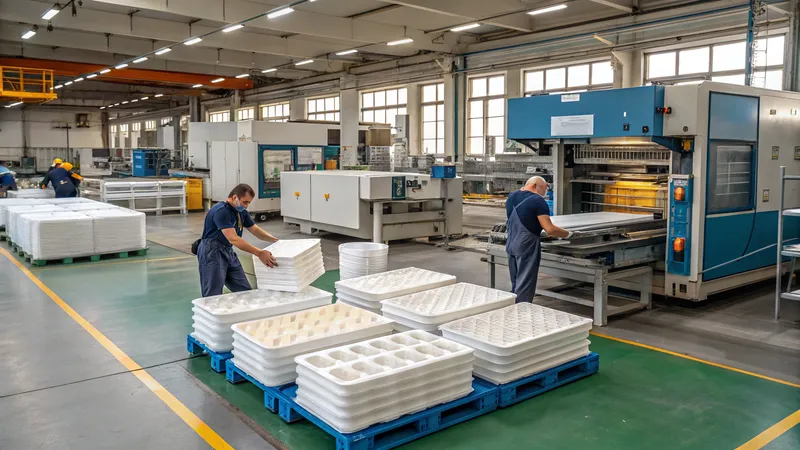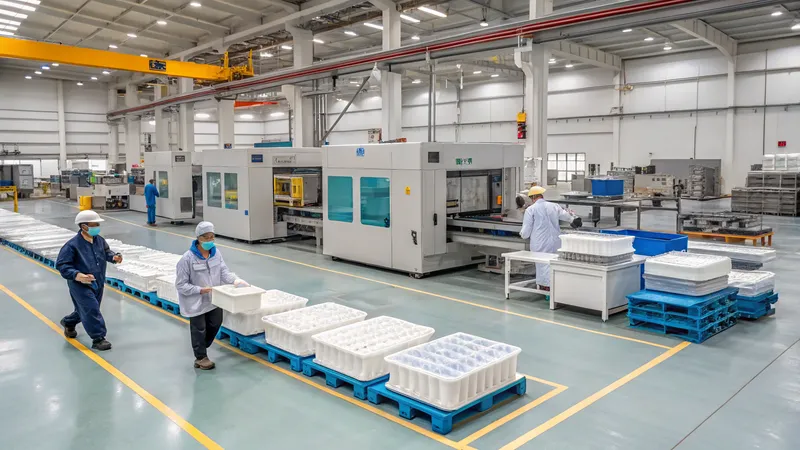Vacuum forming is a versatile and cost-effective manufacturing process1 that shapes heated plastic sheets over molds using vacuum pressure, creating products for industries like packaging, automotive, and medical. This blog post explores the top 10 plastic vacuum forming factories2 in the USA, offering insights into their services, alongside a comprehensive guide to the vacuum forming3 process, its applications, and technical details.
Vacuum forming heats plastic sheets, shapes them over molds with vacuum pressure, and cools them to produce lightweight, durable parts for packaging, automotive, and consumer goods industries.
Vacuum forming is a widely adopted manufacturing technique across multiple industries.True
Its affordability and versatility make it a popular choice for producing parts in packaging, automotive, medical, and more.
Vacuum forming is only used for small-scale production.False
While ideal for low to medium volumes, it can also support larger runs depending on the factory's capabilities.
Top 10 Plastic Vacuum Forming Factories in the USA
Below is a curated list of the top 10 vacuum forming factories in the USA, based on their prominence in industry directories and service offerings:
| Rank | Company Name | Location | Key Services | Website |
|---|---|---|---|---|
| 1 | Productive Plastics | New Jersey | Custom vacuum forming, heavy-gauge thermoforming | Productive Plastics |
| 2 | Advanced Plastiform, Inc. | North Carolina | Custom plastic manufacturing, vacuum forming | Advanced Plastiform |
| 3 | Astro Manufacturing & Design | Ohio | Vacuum forming, CNC machining | Astro Manufacturing |
| 4 | ClearPack Engineering, Inc. | California | Vacuum forming, pressure forming | ClearPack Engineering |
| 5 | CMI Plastics Inc. | New Jersey | Vacuum forming, injection molding | CMI Plastics |
| 6 | Spencer Industries Incorporated | Indiana | Vacuum forming, twin-sheet forming | Spencer Industries |
| 7 | UNIPEC, Inc. | Michigan | Vacuum forming, rotational molding | UNIPEC |
| 8 | Tri-State Plastics, Inc. | Ohio | Vacuum forming, die cutting | Tri-State Plastics |
| 9 | Redline Plastics | Wisconsin | Vacuum forming, rotational molding | Redline Plastics |
| 10 | Universal Plastics | Massachusetts | Vacuum forming, pressure forming | Universal Plastics |
These factories excel in delivering custom solutions for various industries, leveraging advanced equipment and expertise.
What is Vacuum Forming?
Vacuum forming, a type of thermoforming, heats a thermoplastic sheet until pliable, then uses a vacuum to pull it over a mold, cooling it to form a solid shape. It’s valued for its simplicity and cost-effectiveness.
Vacuum forming shapes heated thermoplastic sheets4 over molds using vacuum pressure, ideal for producing large, lightweight parts with moderate detail.

-
Core Principles: Heating softens the plastic, vacuum pressure forms it, and cooling solidifies the shape.
-
Classification:
Vacuum forming can produce highly detailed parts.False
It excels at moderate detail; injection molding is better for high precision.
Common Materials
Vacuum forming uses various thermoplastics6, each suited to specific applications:
| Material | Forming Temperature | Key Properties | Applications |
|---|---|---|---|
| ABS | ~275°F | High impact resistance | Automotive parts |
| PETG | ~250°F | Good clarity, formability | Medical trays |
| HIPS | ~300°F | Low cost, easy to form | Signage |
| Acrylic | ~320°F | High clarity | Lighting fixtures |
Material choice impacts forming temperature7, durability, and aesthetics in vacuum forming.
What are the Steps in the Vacuum Forming Process?
Process Breakdown
The vacuum forming process transforms plastic sheets into finished parts through these steps:
Vacuum forming involves heating, shaping, and cooling plastic sheets over molds, producing parts for packaging, automotive, and medical use.

-
Clamping: Secure the plastic sheet in a frame.
-
Heating: Warm the sheet to its forming temperature (e.g., 275°F for ABS).
-
Forming: Apply vacuum pressure to shape the sheet over a mold.
-
Cooling: Cool the part to set its shape.
-
Trimming: Remove excess material.
-
Finishing: Add secondary operations like painting or drilling.
Vacuum forming requires expensive molds.False
Molds can be made from affordable materials like wood for short runs, keeping costs low.
What are the Key Factors in Vacuum Forming?
Technical Insights
Several factors influence vacuum forming outcomes:

Vacuum forming depends on temperature, vacuum pressure, and mold design, affecting part quality and efficiency.
-
Forming Temperature: Must match the material (e.g., 250°F–350°F).
-
Vacuum Pressure: Ensures tight mold contact.
-
Mold Design: Draft angles (min. 3°) and vent holes are critical.
Material selection is crucial for vacuum forming success.True
Different plastics affect formability, strength, and cost.
What are the Applications of Vacuum Forming?
Industry Uses
Vacuum forming serves diverse sectors with its ability to create large, cost-effective parts:
Vacuum forming produces packaging, automotive components, and medical trays, offering lightweight and affordable solutions.

-
Packaging: Blister packs, trays.
-
Automotive: Dashboards, trim.
-
Medical: Device housings, trays.
-
Consumer Goods: Toys, signage.
Vacuum forming is limited to packaging.False
It’s used across automotive, medical, and consumer goods industries too.
How Does Vacuum Forming Compare to Other Processes?
Comparison Table
Vacuum forming stands out for certain applications compared to alternatives:
| Aspect | Vacuum Forming | Injection Molding | Blow Molding |
|---|---|---|---|
| Tooling Cost | Low | High | Moderate |
| Production Volume | Low to medium | High | Medium to high |
| Part Size | Large | Small to medium | Medium |
| Detail Level | Moderate | High | Moderate |
Vacuum forming excels in low-cost tooling8 and large parts9, unlike injection molding’s precision or blow molding’s hollow shapes.
Conclusion
The top 10 vacuum forming factories in the USA, including Productive Plastics and Advanced Plastiform, offer specialized services for industries needing efficient, lightweight parts. Vacuum forming’s affordability, versatility, and range of applications make it a valuable process. Explore these factories and the detailed insights provided to optimize your manufacturing projects.
-
Learn about the detailed steps involved in the vacuum forming manufacturing process for better insights. ↩
-
Discover the leading factories in the USA that specialize in plastic vacuum forming and their unique offerings. ↩
-
Explore this link to understand the vacuum forming process and its significance in various industries. ↩
-
Discover the various applications and benefits of thermoplastic sheets in manufacturing, which can broaden your understanding of materials used in vacuum forming. ↩
-
Learn about the different mold types in vacuum forming, which is crucial for understanding how to achieve desired shapes and details in production. ↩
-
Understanding thermoplastics is crucial for selecting the right material for your vacuum forming projects. ↩
-
Exploring forming temperature can help optimize your vacuum forming techniques for better results. ↩
-
Learn how low-cost tooling can significantly reduce production expenses and improve efficiency in manufacturing. ↩
-
Explore the industries that utilize large parts from Vacuum forming, and see how it can meet your specific needs. ↩









